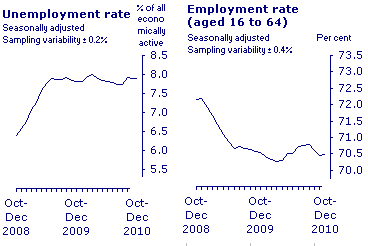UK Unemployment Still Rising: Youth Unemployment Hits Record High
UK unemployment rose by 44,000 to almost 2.5 million in the three months to the end of December, according to the Office for National Statistics (ONS). Youth unemployment rose to a record high, with more than one in five 16 to 24-year-olds out of work after a rise of 66,000 to 965,000 without jobs, prompting renewed concern that young people are bearing the brunt of weakness in the labour market.
North-East England had the largest rise in unemployment, up 1.3 percentage points to a rate of 10.2 per cent, the highest in the UK. The West Midlands also saw a rise of 1.1 points to 9.8 per cent. (see preferred bidders in these regions)
The unemployment rate is now 7.9%, with youth unemployment running at 20.5%.
 The employment rate for those aged from 16 to 64 for the three months to December 2010 was 70.5 per cent, down 0.3 on the quarter. The number of people in employment aged 16 and over fell by 68,000 on the quarter to reach 29.12 million.
The employment rate for those aged from 16 to 64 for the three months to December 2010 was 70.5 per cent, down 0.3 on the quarter. The number of people in employment aged 16 and over fell by 68,000 on the quarter to reach 29.12 million.
The number of employees and self-employed people, who were working part-time because they could not find a full-time job, rose by 44,000 to reach 1.19 million, another high since comparable records began in 1992.
Long-term unemployment also deteriorated, with 17,000 more people out of work for more than a year, to a total of 833,000. The inactivity rate for those aged from 16 to 64 for the three months to December 2010 was 23.4 per cent, up 0.2 on the quarter. The number of economically inactive people aged from 16 to 64 increased by 93,000 over the quarter to reach 9.36 million.
Employment Minister, Chris Grayling, said he was “very concerned” about youth unemployment but added: “We’ve got a long way to go and I want to see these figures start to come down, but certainly the evidence is over the past month things have settled down and we are not seeing the increases we saw earlier in the last quarter,”. He said the government was tackling the issue by creating more apprenticeships and through its planned work programme, which would help more get into work. He said the overall jobless total appeared to be stabilising.
Jobseeker’s Allowance: It is interesting to note that the number of people claiming jobseeker’s allowance, the main unemployment benefit, rose by 2,400 between December 2010 and January 2011 to 1.46 million. Economists had expected a fall of 3,000. The number of male claimants has fallen for twelve consecutive months, with a fall of 5,400 claimants in January 2011 to 1.01 million. But the number of female claimants has increased for seven consecutive months, with an increase of 7,400 claimants in January 2011 to 449,200, the highest figure since October 1996. The number of women aged between 25 and 49 claiming increased by 6,600 on the month to reach 244,500, the highest figure also since comparable records for this series began in 1997.
Most analysts still expect unemployment to rise in the coming months, largely because of the public sector spending cuts being implemented by the government. However, the independent Office for Budget Responsibility thinks the rate will peak at 8.1 per cent before starting to fall.
Source: http://www.statistics.gov.uk/cci/nugget.asp?id=12
Jason McGee-Abe
Project Support Officer






